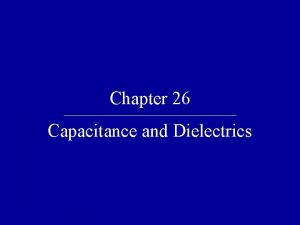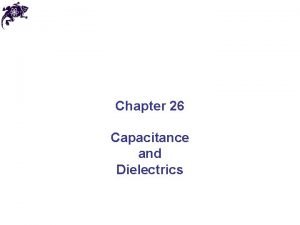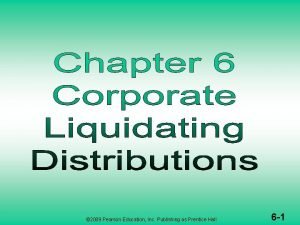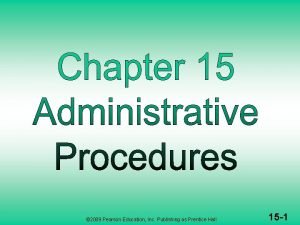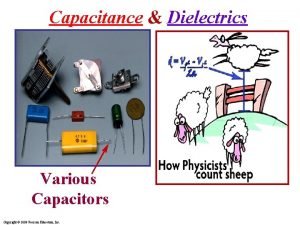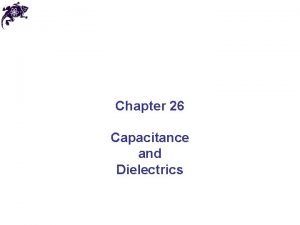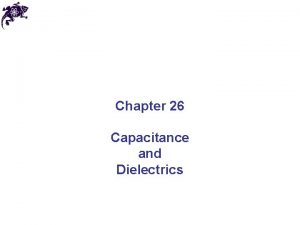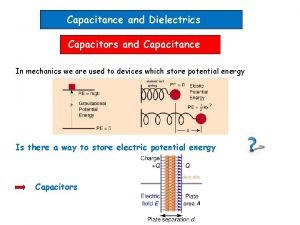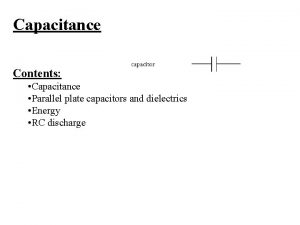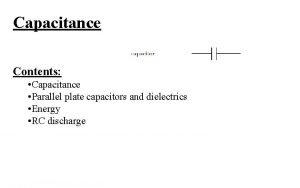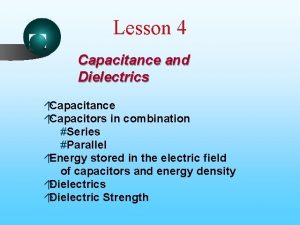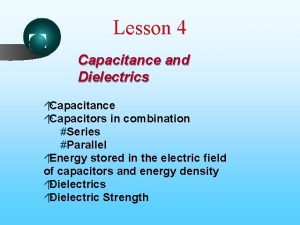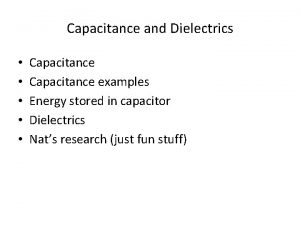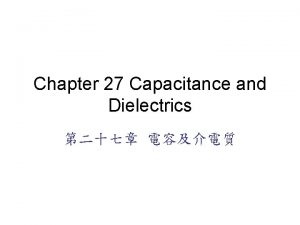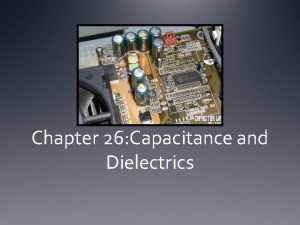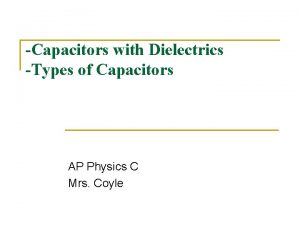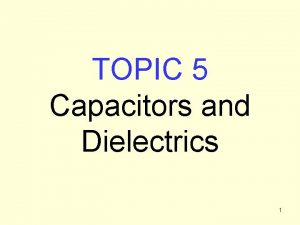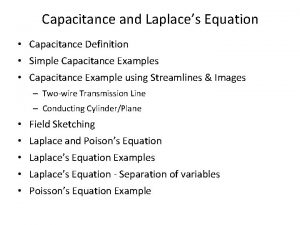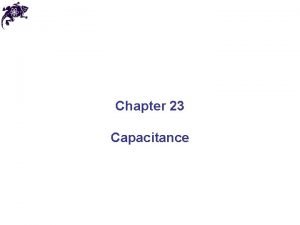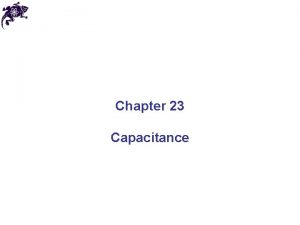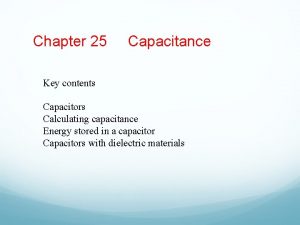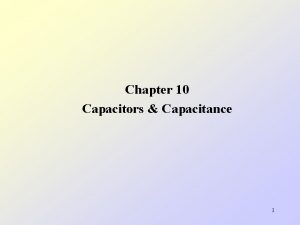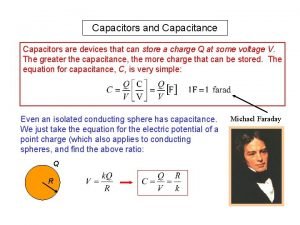Capacitance Dielectrics Various Capacitors Copyright 2009 Pearson Education






























- Slides: 30

Capacitance & Dielectrics Various Capacitors Copyright © 2009 Pearson Education, Inc.

Capacitors - Definition • Capacitor Any configuration of 2 conductors that are close but not touching. • A Capacitor has the ability to store electric charge. A “Parallel Plate” Capacitor Copyright © 2009 Pearson Education, Inc.

Makeup of a Capacitor • A capacitor always consists of 2 conductors. –These are called plates. –When the capacitor is charged, the plates carry charges of equal magnitude & opposite sign. • A potential difference exists between the plates due to the charge. Copyright © 2009 Pearson Education, Inc.

Parallel Plate Capacitor • Each plate is connected to a battery terminal. – The battery is a source of potential difference. • If the capacitor is initially uncharged, the battery establishes an electric field in the wires. • This field applies a force on electrons in the wire just outside of the plates. • The force causes the electrons to move onto the negative plate. Copyright © 2009 Pearson Education, Inc.

Parallel Plate Capacitor, Continued • This process continues until equilibrium is achieved. – The plate, the wire & the terminal are then all at the same potential. • At this point, there is no field in the wire & the movement of the electrons stops. • The plate is now negatively charged. • A similar process occurs at the other plate, electrons moving away from the plate & leaving it positively charged. In its final configuration, the potential difference across the capacitor plates is the same as between the battery terminals. Copyright © 2009 Pearson Education, Inc.

(a) Parallel-Plate Capacitor connected to a battery. (b) A Capacitor in a circuit diagram. Parallel Plate Capacitor Copyright © 2009 Pearson Education, Inc. Capacitor in a circuit

Experiment Shows That • When a capacitor is connected to a battery, the charge Q on its plates is proportional to the battery voltage V, with the proportionality constant equal to the Capacitance C: • This is The Definition of Capacitance. • The SI unit of capacitance is the Farad (F) 1 F = 1 C/V Copyright © 2009 Pearson Education, Inc.

Definition of Capacitance • As we just said, the CAPACITANCE, C, of a capacitor is the ratio of the magnitude of the charge on one plate to the potential difference between the plates. As we also said, the SI capacitance unit is The Farad (F) • The farad is a large unit, typically you will see microfarads (μF) & picofarads (p. F). Capacitance is: 1. 2. 3. 4. Always a positive quantity. Constant for a given capacitor. A measure of the capacitor’s ability to store charge The amount of charge the capacitor can store per unit of potential difference. Copyright © 2009 Pearson Education, Inc.

Calculating Capacitance: General Procedure or “Recipe” For a given geometry 1. Let the plates (A & B) have charges Q & -Q. 2. Calculate the electric field E between the two plates using techniques of previous chapters 3. Calculate the potential difference V between the plates using (parallel plate capacitor). 4. Use C = Q/ V to calculate the capacitance. Copyright © 2009 Pearson Education, Inc.

Example: Parallel Plate Capacitor • Earlier Result: The magnitude of the electric field E between 2 closely space charged plates with charge Q & area A is • For plates of area A, the surface charge density is: σ = (Q/A). So, E between the plates is: E = Q/(ε 0 A). The relation between V & E: • Combining these gives the potential difference VB - VA = (Qd)/(ε 0 A). So, the capacitance of a parallel plate capacitor is: Copyright © 2009 Pearson Education, Inc.

Example: Parallel Plate Capacitor • The charge density on the plates σ = (Q/A). A is the area of each plate. Q is the charge on each plate, equal with opposite signs. • The electric field is uniform between the plates & zero elsewhere. • So, the capacitance is proportional to the area of its plates & inversely proportional to the distance between the plates. Copyright © 2009 Pearson Education, Inc.

Example: Calculate (a) The capacitance C of a parallel-plate capacitor whose plates are 20 cm × 3. 0 cm & are separated by a 1. 0 -mm air gap. Copyright © 2009 Pearson Education, Inc.

Example: Calculate (a) The capacitance C of a parallel-plate capacitor whose plates are 20 cm × 3. 0 cm & are separated by a 1. 0 -mm air gap. Answer C = 53 p. F Copyright © 2009 Pearson Education, Inc.

Example: Calculate (b) The charge Q on each plate if a 12 -V battery is connected across the 2 plates. Copyright © 2009 Pearson Education, Inc.

Example: Calculate (b) The charge Q on each plate if a 12 -V battery is connected across the 2 plates. Answer -10 Q = CV = 6. 4 10 C Copyright © 2009 Pearson Education, Inc.

Example: Calculate (c) The electric field E between the plates. Copyright © 2009 Pearson Education, Inc.

Example: Calculate (c) The electric field E between the plates. Answer 4 E = V/d = 1. 2 10 V/m Copyright © 2009 Pearson Education, Inc.

Example: Calculate (d) An estimate of the area A of the plates needed to achieve a capacitance of C = 1 F, given the same air gap d. Copyright © 2009 Pearson Education, Inc.

Example: Calculate (d) An estimate of the area A of the plates needed to achieve a capacitance of C = 1 F, given the same air gap d. Answer 8 2 A = (Cd/ε 0) = 10 m !!! 2 = 100 km 36 square miles!! Copyright © 2009 Pearson Education, Inc.

• Capacitors can now be made with capacitances of C = 1 F or more, but these are NOT parallel-plate capacitors. They are usually made from activated carbon, which acts a capacitor on a small scale. The capacitance of 0. 1 g of activated carbon is about 1 F. • Some computer keyboards use capacitors; depressing the key changes the capacitance, which is detected in a circuit Copyright © 2009 Pearson Education, Inc.

Example: Cylindrical Capacitor • See figure. A Cylindrical Capacitor consists of a cylinder (or wire) of radius Rb surrounded by a coaxial cylindrical shell of inner radius Ra. • Both cylinders have length ℓ, which is assumed to be much greater than the separation of the cylinders, so “end effects” can be neglected. • The capacitor is charged (by connecting it to a battery) so that one cylinder has charge +Q (say, the inner one) the other one charge -Q. Formula for the capacitance C (using calculus) is: Copyright © 2009 Pearson Education, Inc.

Capacitance of Cylindrical Capacitor Results Notation Change from previous slide! Rb a, Ra b Sorry! The potential difference is V = -2 ke ln (b/a) = (Q/ℓ) So the capacitance is Copyright © 2009 Pearson Education, Inc.

Example: Spherical Capacitor See Figure • A Spherical Capacitor consists of 2 concentric spherical, conducting shells of radii ra & rb. The inner shell carries a uniformly distributed charge Q on its surface. The outer shell carries an equal & opposite charge -Q. Formula for the capacitance C (using calculus) is: Copyright © 2009 Pearson Education, Inc.

Capacitance of a Spherical Capacitor Results Notation Change from previous slide! rb a, ra b Sorry! • The potential difference is: l l l • So, the capacitance is: Copyright © 2009 Pearson Education, Inc.

Example: Capacitance of 2 Long Parallel Wires Estimate the capacitance per unit length C/ℓ of 2 very long straight parallel wires, each of radius R, carrying uniform charges +Q & –Q, separated by a distance d which is large compared to R (d >> R). The line charge density is λ = Q/ℓ Copyright © 2009 Pearson Education, Inc.

Capacitance of 2 Long Parallel Wires E fields from Gauss’s Law: • At x from wire a: Ea = [λ/(2 0 x). Note again: λ = Q/ℓ • At (d – x) from wire b: Eb = [λ/(2 0{d – x})] Copyright © 2009 Pearson Education, Inc.

Capacitance of 2 Long Parallel Wires E fields from Gauss’s Law: • At x from wire a: Ea = [λ/(2 0 x). Note again: λ = Q/ℓ • At (d – x) from wire b: Eb = [λ/(2 0{d – x})] Total: E = Ea + Eb Copyright © 2009 Pearson Education, Inc.

Capacitance of 2 Long Parallel Wires E fields from Gauss’s Law: • At x from wire a: Ea = [λ/(2 0 x). Note again: λ = Q/ℓ • At (d – x) from wire b: Eb = [λ/(2 0{d – x})] Total: E = Ea + Eb Potential Difference: V = Vb – Va = - (Eb - Ea) x. Copyright © 2009 Pearson Education, Inc.

Capacitance of 2 Long Parallel Wires E fields from Gauss’s Law: • At x from wire a: Ea = [λ/(2 0 x). Note again: λ = Q/ℓ • At (d – x) from wire b: Eb = [λ/(2 0{d – x})] Total: E = Ea + Eb Potential Difference: V = Vb – Va = - (Eb - Ea) x. . • Limit: R d – R. Simplifying with the assumption: d >> R gives: V [Q/( 0ℓ )] ln(d/R). Capacitance: C = Q/ V so C ( 0ℓ)/ln(d/R) Copyright © 2009 Pearson Education, Inc.

Capacitance of 2 Long Parallel Wires E fields from Gauss’s Law: • At x from wire a: Ea = [λ/(2 0 x). Note again: λ = Q/ℓ • At (d – x) from wire b: Eb = [λ/(2 0{d – x})] Total: E = Ea + Eb Potential Difference: V = Vb – Va = - (Eb - Ea) x. • Limit: R d – R. Simplifying with the assumption: d >> R gives: V [Q/( 0ℓ )] ln(d/R). Capacitance: C = Q/ V so C ( 0ℓ)/ln(d/R) Copyright © 2009 Pearson Education, Inc.
 2009 pearson education inc
2009 pearson education inc Copyright 2009 pearson education inc
Copyright 2009 pearson education inc Copyright 2009 pearson education inc
Copyright 2009 pearson education inc 2009 pearson education inc
2009 pearson education inc Copyright 2009 pearson education inc
Copyright 2009 pearson education inc Copyright 2009 pearson education inc
Copyright 2009 pearson education inc Capacitor quiz
Capacitor quiz Capacitance and dielectrics
Capacitance and dielectrics Classification of liquid dielectrics
Classification of liquid dielectrics 2009 pearson education inc
2009 pearson education inc 2009 pearson education inc
2009 pearson education inc 2009 pearson education inc
2009 pearson education inc Pearson education 2009
Pearson education 2009 2009 pearson education inc
2009 pearson education inc 2009 pearson education inc
2009 pearson education inc 2017 pearson education ltd
2017 pearson education ltd Copyright pearson education inc
Copyright pearson education inc Copyright 2010 pearson education inc
Copyright 2010 pearson education inc 2018 pearson education inc
2018 pearson education inc 2014 pearson education inc
2014 pearson education inc Copyright 2010 pearson education inc
Copyright 2010 pearson education inc Copyright 2010 pearson education inc
Copyright 2010 pearson education inc Copyright by pearson education inc. answers
Copyright by pearson education inc. answers Copyright 2003 pearson education inc
Copyright 2003 pearson education inc Copyright pearson education inc
Copyright pearson education inc Copyright 2010 pearson education inc
Copyright 2010 pearson education inc Copyright 2010 pearson education inc
Copyright 2010 pearson education inc Copyright 2010 pearson education inc
Copyright 2010 pearson education inc Copyright 2010 pearson education inc
Copyright 2010 pearson education inc Copyright 2010 pearson education inc
Copyright 2010 pearson education inc Composition copyright example
Composition copyright example






